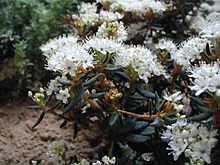Ledum palustre
| Marsh Labrador tea | |
|---|---|
 |
|
| R. tomentosum in flower | |
| Scientific classification | |
| Kingdom: | Plantae |
| (unranked): | Angiosperms |
| (unranked): | Eudicots |
| (unranked): | Asterids |
| Order: | Ericales |
| Family: | Ericaceae |
| Genus: | Rhododendron |
| Species: | R. tomentosum |
| Binomial name | |
|
Rhododendron tomentosum Harmaja |
|
| Synonyms | |
|
Ledum palustre L. |
|
Ledum palustre L.
Rhododendron tomentosum (syn. Ledum palustre), commonly known as marsh Labrador tea, northern Labrador tea or wild rosemary, is a flowering plant in the subsection Ledum of the large genus Rhododendron in the family Ericaceae.
It is a low shrub growing to 50 cm (rarely up to 120 cm) tall with evergreen leaves 12-50 mm long and 2-12 mm broad. The flowers are small, with a five-lobed white corolla, and produced several together in a corymb 3-5 cm diameter. They emit strong smell to attract bees and other pollinating insects.
In North America it grows in northern latitudes in Greenland, Canada, and Alaska, in Europe in the northern and central parts, and in Asia south to northern China, Korea and Japan. It grows in peaty soils, shrubby areas, moss and lichen tundra.
All parts of the plant contain poisonous terpenes that affect the central nervous system. First symptoms of overdose are dizziness and disturbances in movement, followed by spasms, nausea, and unconsciousness. The mere smell of the plant may cause headache to some people.
...
Wikipedia
